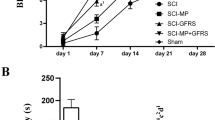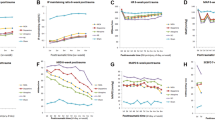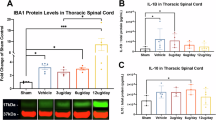Abstract
Study design:
2-amino-5-phosphonovaleric acid (APV) is an N-methyl-D-aspartate (NMDA) receptor blocker and has neuroprotective properties. This study is aimed at evaluating the effect of APV treatment on oxidative status after spinal cord injury (SCI).
Methods:
The experiment was carried out on the following five groups: Group1: sham operated, non-traumatized; Group2: with injured spinal cord, no treatment; Group3: with SCI, injected with 100 μg kg−1 APV; Group4: with SCI, injected with 200 μg kg−1 APV; and Group5: with SCI, injected with 400 μg kg−1 APV. SCI was inflicted by epidural compression with a cerebral vascular clip after T9–11 laminectomy. The experiments were completed after 12 h of trauma. Spinal cords were excised for evaluation of superoxide dismutase (SOD), catalase, reduced glutathione (GSH) and malonyldialdehyde (MDA) levels.
Results:
After SCI, SOD and GSH levels decreased and the MDA level increased significantly. APV treatment decreased the MDA level and increased SOD, catalase and GSH levels. The maximum decrease in MDA was detected in the group treated with 100 μg kg−1 APV compared with the other groups. The GSH level was significantly increased in the group treated with 200 μg kg−1 APV. The SOD level was significantly increased in the group treated with 200 μg kg−1 APV.
Conclusion:
The results of this study have shown that APV treatment creates a dose-dependent antioxidant effect in rats with SCI and may be used for the treatment of SCIs.
Similar content being viewed by others
Log in or create a free account to read this content
Gain free access to this article, as well as selected content from this journal and more on nature.com
or
References
Azbill RD, Mu X, Bruce-Keller AJ, Mattson MP, Springer JE . Impaired mitochondrial function, oxidative stress and altered antioxidant enzyme activities following traumatic spinal cord injury. Brain Res 1997; 765: 283–290.
Kamencic H, Griebel RW, Lyon AW, Paterson PG, Juurlink BH . Promoting glutathione synthesis after spinal cord trauma decreases secondary damage and promotes retention of function. FASEB J 2001; 15: 243–250.
Vaziri ND, Lee YS, Lin CY, Lin VW, Sindhu RK . NAD(P)H oxidase, superoxide dismutase, catalase, glutathione peroxidase and nitric oxide synthase expression in subacute spinal cord injury. Brain Res 2004; 995: 76–83.
Yu F, Sugawara T, Nishi T, Liu J, Chan PH . Overexpression of SOD1 in transgenic rats attenuates nuclear translocation of endonuclease G and apoptosis after spinal cord injury. J Neurotrauma 2006; 23: 595–603.
Micu I, Jiang Q, Coderre E, Ridsdale A, Zhang L, Woulfe J et al. NMDA receptors mediate calcium accumulation in myelin during chemical ischaemia. Nature 2006; 439: 988–992.
Globus MY, Alonso O, Dietrich WD, Busto R, Ginsberg MD . Glutamate release and free radical production following brain injury: effects of posttraumatic hypothermia. J Neurochem 1995; 65: 1704–1711.
Agrawal SK, Fehlings MG . Role of NMDA and non-NMDA ionotropic glutamate receptors in traumatic spinal cord axonal injury. J Neurosci 1997; 17: 1055–1063.
Cho Y, Ueda T, Mori A, Shimizu H, Haga Y, Yozu R . Protective use of N-methyl-D-aspartate receptor antagonists as a spinoplegia against excitatory amino acid neurotoxicity. J Vasc Surg 2005; 42: 765–771.
Haghighi SS, Johnson GC, de Vergel CF, Vergel Rivas BJ . Pretreatment with NMDA receptor antagonist MK801 improves neurophysiological outcome after an acute spinal cord injury. Neurol Res 1996; 18: 509–515.
Wada S, Yone K, Ishidou Y, Nagamine T, Nakahara S, Niiyama T et al. Apoptosis following spinal cord injury in rats and preventative effect of N-methyl-D-aspartate receptor antagonist. J Neurosurg 1999; 91 (1 Suppl): 98–104.
Wrathall JR, Teng YD, Marriott R . Delayed antagonism of AMPA/kainate receptors reduces long-term functional deficits resulting from spinal cord trauma. Exp Neurol 1997; 145 (2 Pt 1): 565–573.
Robert F, Bert L, Stoppini L . Blockade of NMDA-receptors or calcium-channels attenuates the ischaemia-evoked efflux of glutamate and phosphoethanolamine and depression of neuronal activity in rat organotypic hippocampal slice cultures. C R Biol 2002; 325: 495–504.
Iizuka H, Yamamoto T, Iwasaki Y, Konno H, Kadoya S . Experimental spinal cord injury: quantification of axonal damage by automated image analysis. J Neurosurg 1986; 64: 304–308.
Winterbourn CC, Hawkins RE, Brian M, Carrell RW . The estimation of red cell superoxide dismutase activity. J Lab Clin Med 1975; 85: 337–341.
Beutler E . The glutathione instability of drug-sensitive red cells; a new method for the in vitro detection of drug sensitivity. J Lab Clin Med 1957; 49: 84–95.
Ohkawa H, Ohishi N, Yagi K . Assay for lipid peroxides in animal tissues by thiobarbituric acid reaction. Anal Biochem 1979; 95: 351–358.
Beutler E . Red Cell Metabolism, A Manual of Biochemical Methods. Grune & Stratton: New York, 1973.
Halliwell B . Reactive oxygen species in living systems: source, biochemistry, and role in human disease. Am J Med 1991; 91 (3C): 14S–22S.
Hulsebosch CE . Recent advances in pathophysiology and treatment of spinal cord injury. Adv Physiol Educ 2002; 26: 238–255.
Mu X, Azbill RD, Springer JE . NBQX treatment improves mitochondrial function and reduces oxidative events after spinal cord injury. J Neurotrauma 2002; 19: 917–927.
Author information
Authors and Affiliations
Corresponding author
Rights and permissions
About this article
Cite this article
Vural, M., Arslantaş, A., Yazihan, N. et al. NMDA receptor blockage with 2-amino-5-phosphonovaleric acid improves oxidative stress after spinal cord trauma in rats. Spinal Cord 48, 285–289 (2010). https://doi.org/10.1038/sc.2009.100
Received:
Revised:
Accepted:
Published:
Issue date:
DOI: https://doi.org/10.1038/sc.2009.100
Keywords
This article is cited by
-
Mitochondrial Division Inhibitor 1 Ameliorates Mitochondrial Injury, Apoptosis, and Motor Dysfunction After Acute Spinal Cord Injury in Rats
Neurochemical Research (2015)
-
Neuroprotective Effects of PEP-1-Cu,Zn-SOD against Ischemic Neuronal Damage in the Rabbit Spinal Cord
Neurochemical Research (2012)



